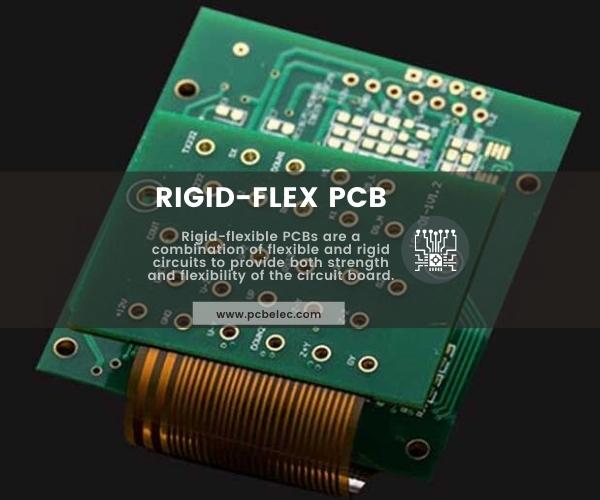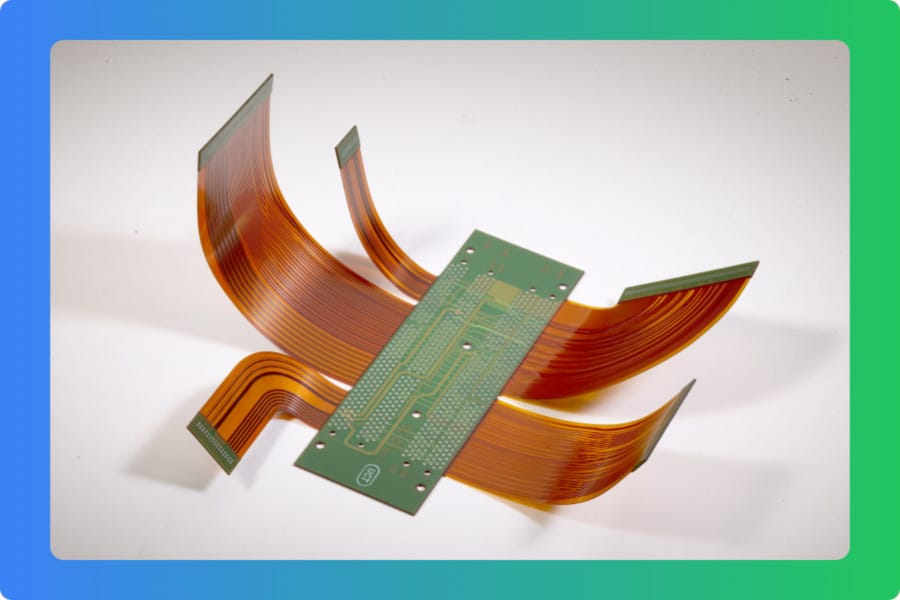Rigid-flex PCBs combine the best of rigid and flexible circuits, offering improved reliability, streamlined assembly and cutting production costs by up to 50%. This guide explores the key advantages of rigid-flex PCBs over conventional PCBs and their wide-ranging applications across industries.
What Are Rigid-Flexible PCB?
Rigid-flexible PCBs combine flexible and rigid circuits to provide both strength and flexibility of the circuit board. Rigid-flexible PCBs are made of flexible layers of substrate materials which are joined together using a pre-preg bonding sheet or film and afterward attached to the rigid part of the PCB. The integrated circuit created by the combination of rigid and flexible circuits is connected via cut-through holes, having the finest features of both flexible and rigid circuits.

In rigid-flexible PCBs, the flex PCB is usually one-sided whereas the rigid PCB might be a multilayer PCB. The rigid part of the PCB provides an area where components are soldered, while the flexible part of the PCB is used to maintain connections with the rigid part of the board. The major reasons for creating rigid-flexible circuits are improved flexibility, a minimal thickness of the flex, and reduced cost of the parts of a rigid-flexible circuit. Other reasons are:
- It Improves the circuit’s ability to transmit signals with no loss
- It allows controlled impedance which offers consistent high-frequency performance.
- Eliminates connection issues like cold joints
- Minimizes weight
- Frees space in the Board for other electronic components
All rigid-flexible PCBs are divided into various zones consisting of different layers and materials. The Rigid zones in the integrated circuitry could have more layer counts than the flexible zones. The materials used as substrate changes also from FR-4 into polyimide in the transition zones. Complex designs mostly change from rigid into flex and then to rigid several times. As the transition takes place, the overlapping of the rigid d-flexible materials requires the cut-through holes to separate from the transition zones to maintain the integrity of the process. In addition, a lot of rigid-flexible designs include aluminum stiffeners or stainless steel that supports the components and connectors.
Advantages of Rigid-Flexible PCBs

- Flexible design alternatives: The Flexible circuitry in a rigid-flexible PCB accepts any connector or component that could be assembled into a rigid printed circuit board design that supports high complex configurations. Where extra support may be required, the designs become rigid and are flexible around sections and corners that require much space.
- Reduction in weight and size of the package: The combination of flex circuits and rigid boards enables you to simplify your design and produce a package that is reduced in weight and size. You will be able to create circuitry that fits your device rather than the opposite.
- High component density applications: Industrialists and manufacturers are under pressure always to integrate more premium technology in little space and material. High component density in rigid-flexible PCBs is necessary for certain applications where the use of rigid and flexible circuits separately are unable to accomplish the project requirements. Controlled impedance rigid-flexible PCBs design (which offer a consistent performance of high frequency) circuitry support devices made of lightweight conductors with high-component density, thereby creating space for many product features.
- Minimum interconnections and parts: Compared to regular circuit boards, rigid-flexible PCBs need fewer connections, parts, and less assembling of the connectors. This increases productivity.
- Reliability in connection: Fewer interconnections minimize various potential sources of error, which in turn increases reliability.
- Reduction in assembly cost: With fewer connections and parts, assembly and purchase costs are reduced. This also helps to eliminate the risks that may occur within your product supply chain. It is advisable you carry out a feasibility study of the prototype to reduce the time for the development of a product and significantly minimize the product’s costs of production.
- Reduction in vibration and shock impact: Electronic components which are heavy may experience vibration and shock as a result of mechanical resonance. However, with rigid-flexible PCBs, you don’t have to be worried about such problems as rigid-flex PCBs are able to resist high temperature, radiation, heat, shock, and other tough conditions.
Applications Of Rigid-Flexible PCBs
The growing trend of miniaturizing or reducing electronic systems and devices requires high-quality flexible PCBs. And rigid-flexible PCBs are an integral part of this, which has made rigid-flexible PCBs become increasingly popular in the technology market. Several of the advantages of rigid-flexible PCBs discussed in the previous section that made them more popular has earned rigid-flexible PCBs numerous applications in the commercial and industrial market from little consumer products such as multimedia players and phones to advanced avionics/military systems.
Applications of rigid-flexible PCBs include:
- Medical industry-Handheld monitors, pacemakers, cochlear implants, imaging equipment, wireless controllers, and others.
- Manufacturing of military equipment-Communication systems, weapon guidance systems, GPS, tracking or surveillance systems, aircraft midsole-launching detectors, and others.
- Aerospace industry-Control tower electronic systems, radio communication equipment and systems, radar equipment, motion sensors, climate and environmental test chambers, sensors, vibration, and noise testing systems, and others.
- Telecommunication industry-Base stations, communication satellites, signal processing electronic systems, servers and routers, networked signal expansion electronic systems, handheld units, wireless communication electronic systems, transmission media, and others.
- Automotive industry-Electronics Control Module, LCD Displays, music systems, transmission controls, navigation systems, entertainment systems, AC systems, and others.
- Industrial/Manufacturing Industry-Test equipment, control panels, industrial automation electronic systems, electrical switches, industrial ACs, CCTV surveillance electronic systems, and others.
- Consumer appliances-TV remotes, solar power controllers, UV water purification machines, electronic irons, washing machines, oven, lighting systems, and others.
Conclusion
As an innovative solution integrating the strengths of rigid and flexible circuits, rigid-flex PCBs offer a myriad of unique advantages. Their compact design not only enables high-density component layouts and optimized weight/space savings, but also supports intricate form factors and stringent reliability requirements.
From advanced aerospace testing and control systems to portable medical monitoring devices; from integrated automotive navigation and infotainment units to flexible 5G telecom base station deployments – rigid-flex PCBs have demonstrated unparalleled performance capabilities across diverse applications.
With over two decades of extensive experience in PCB manufacturing, JHYPCB has emerged as an industry pioneer, providing global customers with one-stop rigid PCB (up to 64 layers), flex PCB (up to 12 layers), and rigid-flex PCB solutions.
Whether standardized products or customized services, our rigid-flex PCB product line synergistically combines high reliability, precision manufacturing, and stringent quality control to ensure outstanding performance of your electronics under even the harshest operating conditions.
Our dedicated application engineering team is ready to work closely with you to efficiently address your project requirements and tailor optimal rigid-flex PCB solutions. Unleash the limitless potential of rigid-flex PCBs and embrace the next leap for your electronic products, starting today!
Related Reading
- Key Process Flow of Rigid-Fled PCB Production
- What factors determine the price of PCB?
- What is Flexible PCB Prototype?
- Development and Applications of FPC Flexible PCB
- 16 Factors Affecting The Cost And Price of Flexible PCB
- What is a Multilayer PCB and What are the Advantages?
- What is a PCB Manufacturer? The Definitive Guide
- Custom Flex PCB:Tailored Solutions for Your Applications
- Custom PCB Fabrication in China – Prototyping & Mass Production
- Rapid PCB Prototyping and Production – The Keys to Accelerating Your Product Launch
- JHYPCB: The Best Prototype PCB Manufacturer for Your Needs
- Applications of Different Types of PCBs in Major Industries
- What Is Flexible PCB Coverlay (FPC Cover Layer)?
- The Manufacturing Process Of Double-sided Flexible PCB Coverlay
- Rigid PCB vs Flex PCB: What Is The Difference?
- The terms you have to know related to the manufacture of Flexible PCB
- Knowledge of Flexible PCB Manufacturing Process Steps












